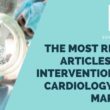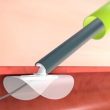01- Surgeons’ Claim on Low-Risk Patients with Aortic Stenosis Recent randomized trials including low-risk patients showed positive results for transcatheter aortic valve replacement (TAVR) compared with surgical aortic valve replacement. Read more HERE 02- Major Cause of Myocardial Injury by COVID-19 The most common cause of myocardial necrosis in patient undergoing COVID-19 infection is microthrombi. These...
Angioplasty in Aspirin-Free Stable Patients with Prasugrel: Innovation Continues
Potent P2Y12 receptor inhibitors, such as prasugrel and ticagrelor, have been tested mainly in a setting of acute coronary syndromes. There is little evidence on stable patients, particularly for prasugrel. Designing a study with that purpose seemed challenging enough, but adding aspirin discontinuation in patients without a particularly high bleeding risk took this research to...
SOLACI Peripheral | Clinical Case Discussion
SOLACI’s Department of Peripheral Endovascular Interventions is promoting the analysis of challenging clinical cases on peripheral interventions so as to foster the participation and engagement of all SOLACI members. In this first issue, we present a clinical case around carotid artery stenting. Read thoroughly the case below and take part in an unrestricted discussion through...
The Most Read Scientific Articles of January in Solaci.org
01- Soon after the EXCEL “Scandal” the NOBLE 5-year Outcomes Come Out: Mere Coincidence? There is no such thing as coincidence, at least not for the evidence-based medical science. This is what the NOBLE 5-year outcomes, soon to be published in the Lancet, seem to say, in line with the BBC exposé of the EXCEL...
Long-Term Foramen Ovale Closure after Cryptogenic Stroke
Patent foramen ovale closure is the standard treatment for cryptogenic stroke patients. However, there are is little information on its long-term evolution. The aim of this study was to determine clinical outcomes (death, ischemic or bleeding events) after foramen ovale closure over a 10-year evolution. The study included 201 consecutive patients (mean age 47...
The Most Relevant Articles of 2018 in Peripheral Vascular Disease
1- What’s New in the European Guidelines on Peripheral Arterial Disease Since the last version of the European guidelines on the diagnosis and treatment of peripheral arterial disease in 2011, there have been many trials and registries that warrant guideline adjustments in many aspects. The first novelty is the teamwork that gave way to these...
MR CLEAN Registry: “Time is Brain” is a Far More Accurate than “Time is Heart”
Time to endovascular treatment after ischemic stroke is strongly associated to functional outcomes. This association could be even stronger than previously suggested in more select populations of controlled studies. These findings emphasize that functional outcomes after endovascular treatment could be improved significantly by reducing onset to treatment times. Randomized studies in select acute...
Peripheral Vascular Disease Is Associated to More Events in TAVR
Courtesy of Dr. Carlos Fava. The incidence of peripheral vascular disease (PVD) is increasing and associated with negative outcomes when overlapping with cardiovascular disease. In patients undergoing TAVR, its prevalence varies between 28% and 42%, according to different studies. However, its real impact on the rate of survival is still unclear. This study analyzed 27,440 patients >65 years...
Early Coronary Angiography in High-Risk Non-ST-Elevation ACS
Coronary angiography is essential for patients admitted with non-ST-elevation acute coronary syndrome, since it allows physicians to confirm the diagnosis, stratify the risk, and define the revascularization and antithrombotic management strategies. There is no doubt that these patients should be studied invasively, but the timing for that is still uncertain. Coronary catheterization within...
With Absorb Out, New Resorbable Scaffolds Have Come onto the Market
By restoring vascular physiology and eliminating the inflammatory focus and the chance of fracture and neo atherosclerosis inherent to DES, bioresorbable scaffolds offer the potential to improve long term outcomes. A number of bioresorbable materials have been tested, mainly polylactic acid, with several limitations that have taken the Absorb bioresorbable scaffold out of the market....









